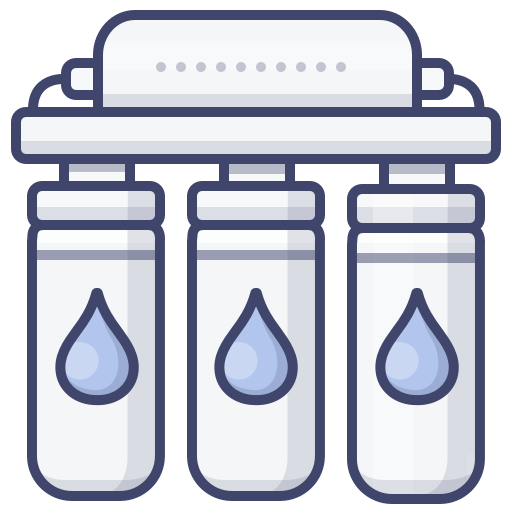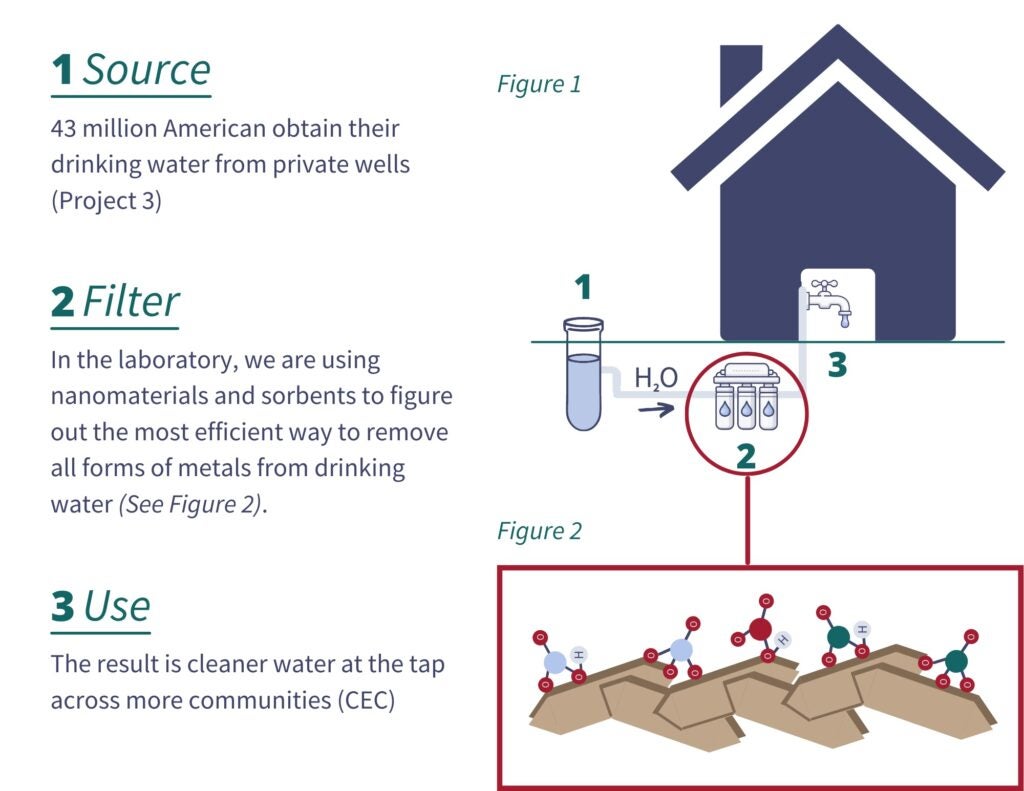MEMCARE-SRC
The Metals and Metal Mixtures, Cognitive Aging, Remediation and Exposure Sources (MEMCARE) Superfund Research Center aims to understand how metals and metal mixtures contribute to cognitive decline in older age and the biological mechanisms underlying these effects; and to develop new ways to detect and remove metal contaminants in drinking water sources.
677 Huntington Avenue
Boston, MA 02115
Project 4: Reducing community exposures

Designing the next generation of highly selective sorbents for water remediation
Removing metals and other chemicals that can contaminate drinking water is critical for public health, but traditional approaches to filter and remove neurotoxic metals are not sufficiently selective in the presence of other non-toxic ions, which frequently occur at higher concentrations, have similar chemical structures, and compete for sorption sites.
Project Goals

This project aims to develop a drinking water filter technology that:
- Selectively removes neurotoxic oxo-anions from drinking water by adsorption.
- Can be used for a variety of water treatment systems (e.g., individual households, on well water, small-scale community systems or schools).
- Are more effective, efficient, and sustainable than existing technologies.
Our Approach
Recent advances in polymer- and nano- science allow for unprecedented bottom-up capabilities to thermodynamically model, characterize, and controllably synthesize adsorbents. Project 4 is designing selectively adsorptive polymers based on the waste bio-polymer chitosan and metal oxides particles. By selectively exposing different surfaces of the metal oxide particles, we are able to exploit chemical behavioral differences such as polarity, charge distribution, size, and hydrophobicity between the target oxoanion metal pollutants and other naturally occurring competing ions, to generate highly selective and tunable polymeric and nano-surfaces.

Project Team
Recent Publications
2024
Boyer TH, Briese E, Crane L, Bhadha J, Call DF, McLamore ES, Rittmann B, Tuberty S, Westerhoff P, Duckworth OW. Guidance on aqueous matrices for evaluating novel precipitants and adsorbents for phosphorus removal and recovery. Chemosphere. 2024 Nov;367:143648.
Nwokonkwo O, Muhich C. Mechanistic Insights into the Selectivity for Arsenic over Phosphate Adsorption by Fe3+-Cross-Linked Chitosan Using DFT. J Phys Chem B. 2024 Feb 22;128(7):1689-1699.
Chung-Seop Lee, Heuidae Lee, Shahnawaz Sinha, Alireza Farsad, Paul Westerhoff, and Hojung Rho. 2024. “Mini-cores of activated carbon block simulate full-sized performance for removing organics and arsenate from drinking water.” Water Research, 267, Pp. 122461.
Chao Zeng, Amin Mojiri, Jirapat Ananpattarachai, Alireza Farsad, and Paul Westerhoff. 2024. “Sorption-based atmospheric water harvesting for continuous water production in the built environment: Assessment of water yield and quality.” Water Research, 265, Pp. 122227.
Akhlak U Mahmood, Minhazul Islam, Alexey V Gulyuk, Emily Briese, Carmen A Velasco, Mohit Malu, Naushita Sharma, Andreas Spanias, Yaroslava G Yingling, and Paul Westerhoff. 2024. “Multiple Data Imputation Methods Advance Risk Analysis and Treatability of Co-occurring Inorganic Chemicals in Groundwater.” Environ Sci Technol, 58, 46, Pp. 20513-20524.
Briese E, Niimi K, Hjelmstad A, and Westerhoff P. 2024. “Surface Complexation and Packed Bed Mass Transport Models Enable Adsorbent Design for Arsenate and Vanadate Removal.” ACS ES&T Eng. 2024 Oct 11;4(10):2563-2572.
Obinna Nwokonkwo and Christopher Muhich. 2024. “Mechanistic Insights into the Selectivity for Arsenic over Phosphate Adsorption by Fe-Cross-Linked Chitosan Using DFT.” J Phys Chem B, 128, 7, Pp. 1689-1699.
2023
Amber Wutich, Patrick Thomson, Wendy Jepson, Justin Stoler, Alicia D Cooperman, James Doss-Gollin, Anish Jantrania, Alex Mayer, Jami Nelson-Nuñez, Shane W Walker, and Paul Westerhoff. 2023. “MAD Water: Integrating Modular, Adaptive, and Decentralized Approaches for Water Security in the Climate Change Era.” WIREs Water, 10, 6.
Francisco Léniz-Pizarro, Holly E Rudel, Nicolas J Briot, Julie B Zimmerman, and Dibakar Bhattacharyya. 2023. “Membrane Functionalization Approaches toward Per- and Polyfluoroalkyl Substances and Selected Metal Ion Separations.” ACS Appl Mater Interfaces, 15, 37, Pp. 44224-44237.
Alireza Farsad, Mariana Marcos-Hernandez, Shahnawaz Sinha, and Paul Westerhoff. 2023. “Sous Vide-Inspired Impregnation of Amorphous Titanium (Hydr)Oxide into Carbon Block Point-of-Use Filters for Arsenic Removal from Water.” Environmental Science & Technology, 57, 48, Pp. 20410-20420.
Obinna Nwokonkwo, Vivienne Pelletier, Michael Broud, and Christopher Muhich. 9/8/2023. “Functionalized Ferrocene Enables Selective Electrosorption of Arsenic Oxyanions over Phosphate─A DFT Examination of the Effects of Substitutional Moieties, pH, and Oxidation State.” The Journal of Physical Chemistry A, Pp. null.
Holly E Rudel and Julie B Zimmerman. 2023. “Elucidating the Role of Capping Agents in Facet-Dependent Adsorption Performance of Hematite Nanostructures.” ACS Appl Mater Interfaces, 15, 29, Pp. 34829-34837.
Elliot Reid, Thomas Igou, Yangying Zhao, John Crittenden, Ching-Hua Huang, Paul Westerhoff, Bruce Rittmann, Jörg E Drewes, and Yongsheng Chen. 2023. “The Minus Approach Can Redefine the Standard of Practice of Drinking Water Treatment.” Environ Sci Technol, 57, 18, Pp. 7150-7161.
Alireza Farsad, Ken Niimi, Mahmut Selim Ersan, Jose Ricardo Gonzalez-Rodriguez, Kiril D Hristovski, and Paul Westerhoff. 2023. “Mechanistic Study of Arsenate Adsorption onto Different Amorphous Grades of Titanium (Hydr)Oxides Impregnated into a Point-of-Use Activated Carbon Block.” ACS ES&T Engineering, 3, 7, Pp. 989 – 1000.
Srishti Gupta, Adam Chismar, and Christopher Muhich. 3/30/2023. “Understanding the Effect of Single Atom Cationic Defect Sites in an Al2O3 (012) Surface on Altering Selenate and Sulfate Adsorption: An Ab Initio Study.” J. Phys. Chem. C, 127, 14, Pp. 6925-6937.
2022
Naushita Sharma, Paul Westerhoff, and Chao Zeng. 2022. “Lithium occurrence in drinking water sources of the United States.” Chemosphere, 305, Pp. 135458.
Srishti Gupta, Ngan Anh Nguyen, and Christopher L Muhich. 2022. “Surface water H-bonding network is key controller of selenate adsorption on [012] α-alumina: An Ab-initio study.” J Colloid Interface Sci, 617, Pp. 136-146.
2021
Lauren N Pincus, Predrag V Petrović, Isabel S Gonzalez, Eli Stavitski, Zachary S Fishman, Paul T Anastas, and Julie B Zimmerman. 2021. “Selective adsorption of arsenic over phosphate by transition metal cross-linked chitosan.” Chem Eng J, 412.
Chung-Seop Lee, Sujin Guo, Hojung Rho, Juliana Levi, Sergi Garcia-Segura, Michael S Wong, Jorge Gardea-Torresdey, and Paul Westerhoff. 2021. “Unified Metallic Catalyst Aging Strategy and Implications for Water Treatment.” Environ Sci Technol.
Chu C, Huang D, Gupta S, Weon S, Niu J, Stavitski E, Muhich C, and Kim JH. 8/30/2021. “Neighboring Pd single atoms surpass isolated single atoms for selective hydrodehalogenation catalysis.” Nat Commun, 30, 12(1), Pp. 5179.
Baiyang Chen, Jingyi Jiang, Xin Yang, Xiangru Zhang, and Paul Westerhoff. 2021. “Roles and Knowledge Gaps of Point-of-Use Technologies for Mitigating Health Risks from Disinfection Byproducts in Tap Water: A Critical Review.” Water Res, 200, Pp. 117-265.
Paul Westerhoff, Pedro JJ Alvarez, Jaehong Kim, Qilin Li, Alessandro Alabastri, Naomi J Halas, Dino Villagran, Julie Zimmerman, and Michael S Wong. 2021. “Utilizing the broad electromagnetic spectrum and unique nanoscale properties for chemical-free water treatment.” Current Opinion in Chemical Engineering, 33.
J Kidd, P Westerhoff, and A Maynard. 4/22/2021. “Survey of Industrial Perceptions for the Use of Nanomaterials for In-Home Drinking Water Purification Devices.” NanoImpact, 22, 100320, Pp. 1-6.
2020
Holly E Rudel, Mary Kate M Lane, Christopher L Muhich, and Julie B Zimmerman. 2020. “Toward Informed Design of Nanomaterials: A Mechanistic Analysis of Structure-Property-Function Relationships for Faceted Nanoscale Metal Oxides.” ACS Nano.
Lauren N Pincus, Holly E Rudel, Predrag V Petrović, Srishti Gupta, Paul Westerhoff, Christopher L Muhich, and Julie B Zimmerman. 2020. “Exploring the Mechanisms of Selectivity for Environmentally Significant Oxo-Anion Removal during Water Treatment: A Review of Common Competing Oxo-Anions and Tools for Quantifying Selective Adsorption.” Environ Sci Technol, 54, 16, Pp. 9769-9790.